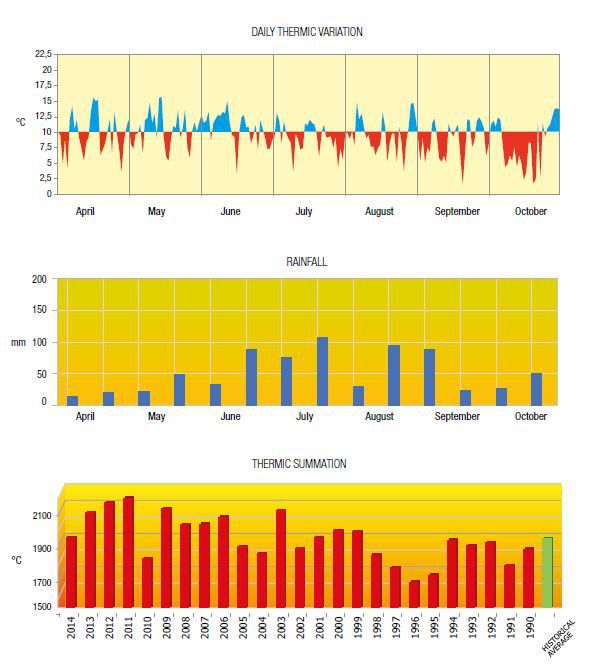VINTAGES
VINTAGE 2014
2014 GROWING YEAR
This growing year will be remembered as a challenging one with regard to vineyard operations and in particular for ensuring that the grapes remained healthy and ripened to perfection.
Frequent rains and a decidedly cool summer negatively impacted vine development, slowing growth and drawing out the ripening process.
The growing season started off with a mild winter, with brought a budbreak that was about 17 days earlier than normal, a situation encouraged as well by a fairly dry March. April was characterised by very warm days, but by significant day-night temperature differentials too, with a low point of – 2°C on 16 April, which caused late-season freezes in the most sensitive grape varieties.
Flowering began around 15 May in the early varieties--pinot grigio and chardonnay--, some 13 days early compared to the historical average. Cool days during this month lengthened the flowering to 14 days, thus cancelling out the head start witnessed earlier in the year.
With the beginning of fruit-set, in mid-June, a long period of cool weather and often cloudy days set in, bringing high temperatures that were below average by about 2°C; just after fruit-set concluded, at the end of June, rains became quite frequent, lasting through all of July and August, months that are usually completely dry.
During these unsatisfactory weather conditions, and particularly beginning in August, the first symptoms of mould and Botrytis began to appear on the most compact grape clusters. In such conditions, vineyard management operations assume a crucial importance, and manual canopy management is necessary to modify the micro-climate surrounding the cluster zone. Thus, we repeatedly went through the vineyards, removing the basal leaves near the clusters to give them increased direct sunlight, performing green harvesting to distribute the clusters more evenly throughout the zone, and even, in some varieties, working directly on the individual clusters, removing the tips or wings in order to reduce compactness or cluster size.
The ripening process was fairly slow, and it was of fundamental importance to exercise patience and calmly wait until the grapes achieved aromatic ripeness, avoiding picking too early because of anxiety and weather instability.
The harvest too, executed entirely by hand, was slower than usual, since the pickers had to pay attention to the health of each individual cluster, and to do this properly we had to substantially increase the number of pickers.
Looking for weather conditions similar to 2015, the years 2010, 2005, 1998, 1996, and 1989 come to mind; all of them yielded wines that evolved very slowly, allowing them--particularly several vintages--to achieve a notable minerality and longevity. Thus, 2014, with cool continental weather completely replacing the Mediterranean model, brought us a classic “cool climate” vintage.
Wine characteristics of this vintage are lower alcohols (± - 1%), average acidities but higher levels of malic acid, more vertically-expressed nose and palate, and a bouquet tending more towards the floral, citrus, and mineral rather than to ripe and tropical fruit.

